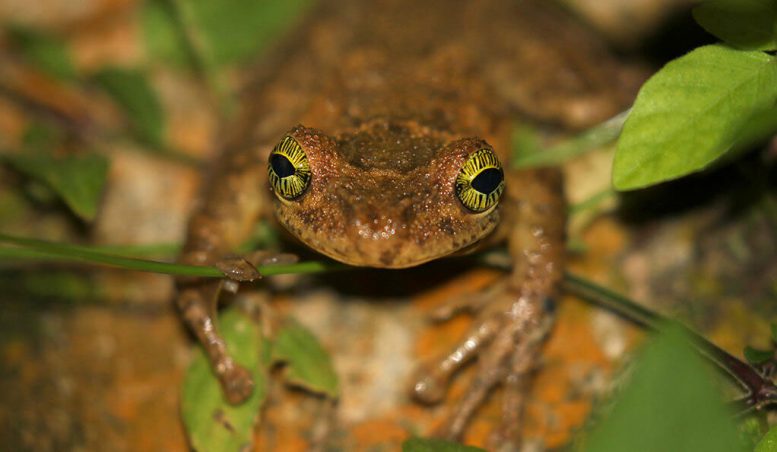
The Manaus slender-legged tree frog (Osteocephalus taurinus), a nocturnal species in South America. (Photo credit: Walter Jetz)
A new study by researchers at Yale and George Washington University examines the human threats to the amphibian family tree and calls for a rethinking of conservation priorities to preserve species diversity and evolutionary heritage.
Amphibians represent an important bellwether of global change, scientists say, due to their particularly high sensitivity to disturbances in their environment. There are more than 7,000 amphibian species on Earth, including frogs, toads, caecilians, newts, mudpuppies, and hellbenders.
“Amphibians are a globally endangered group for which threats from global change are outpacing our ability to safeguard species,” said Walter Jetz, lead author of a paper published online March 26 in the journal Nature Ecology & Evolution. Jetz is an associate professor of ecology and evolutionary biology at Yale and director of the Yale Center for Biodiversity and Global Change.
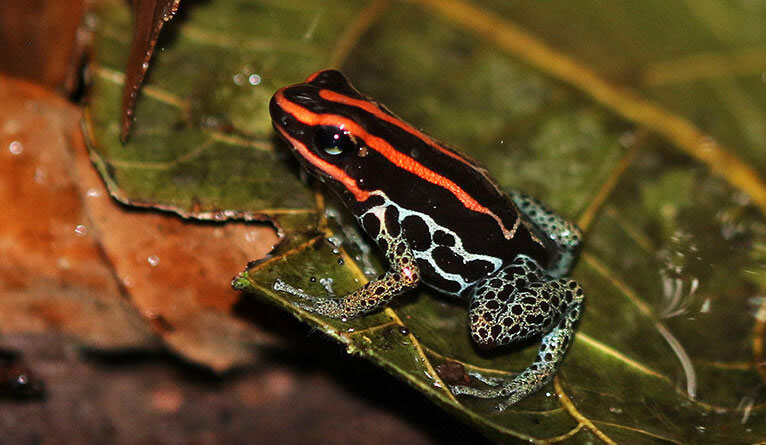
A species of the poison dart frog family (Dendrobatidae). Many poison dart frogs are now under severe threat of extinction. (Photo credit: Walter Jetz)
Jetz and co-corresponding author R. Alexander Pyron of George Washington constructed the first comprehensive family tree for nearly all amphibious species alive today. The researchers used the data to examine the historical diversification patterns of amphibians as well as the species’ level of isolation on the family tree, also called evolutionary distinctness.
Amphibians are the most ancient group of terrestrial vertebrates surviving today, with origins reaching back more than 300 million years. The authors found that select members of this group alive today carry more than 100 million years of evolutionary history distinct to only them. The long, separate path of these species may have resulted in the evolution of key functions for varied ecosystems. Thanks to the early origin of the group, such highly distinct species are found in all parts of the world.
With many species still insufficiently studied in the wild to appreciate their risk of extinction or potential functions for the ecosystem, the researchers said, knowing their evolutionary distinctness and place on the family tree can provide invaluable insights. “A worldwide focus on all species allows us to link threats and evolutionary history across regions in a way that was not possible previously,” Pyron said.
The researchers found that neither the type nor intensity of human threat to amphibian species was associated with their evolutionary distinctness. This means there is significant potential for conservation action to mitigate the effect human activities have on the amphibian tree of life, Jetz said.
“Our evaluation provides key baseline information for all extant amphibians that may help identification of threats and prioritization of research and conservation,” Jetz said. “We expect this information to be widely helpful for the large community of scientists and conservationists interested in amphibians, and to empower national and local conservation efforts.”
The research is supported, in part, by the National Science Foundation.
Reference: “The interplay of past diversification and evolutionary isolation with present imperilment across the amphibian tree of life” by Walter Jetz and R. Alexander Pyron, 26 March 2018, Nature Ecology & Evolution.
DOI: 10.1038/s41559-018-0515-5

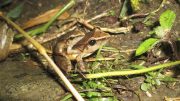
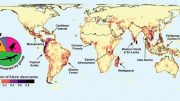
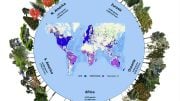
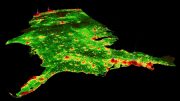


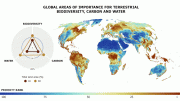

Be the first to comment on "Researchers Reveal Human Threats to the Amphibian Tree of Life"